![]()
![]()
![]()
Use LEFT and RIGHT arrow keys to navigate between flashcards;
Use UP and DOWN arrow keys to flip the card;
H to show hint;
A reads text to speech;
25 Cards in this Set
- Front
- Back
|
Gandhāra Gandhāran Style |
Ancient Kingdom 100 BCE - 1200 CE Buddhist Art with heavy cross-culture influence from Greek, Persian, Syrian, and Indian influences. Alexander the Great involves with Greco-Buddhist art. |
|
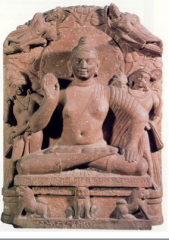
|
Seated Buddha with Attendants A.D 82 Red Sandstone Soft Figure, belly, and bosoms Charkras on feets and hands Halo Wet Drapery technique. Shows torso Greek inspired technique |
|
|
Shakyamuni Buddha |
Buddha's name after enlightenment |
|
|
Siddhartha Gautama |
Buddha's name assigned at birth |
|
|
Four Noble Truths |
The Four Noble Truths are the truth of suffering, the truth of the cause of suffering, the truth of freedom from suffering, and thetruth of the way to eliminate suffering, which is the Eightfold Path. |
|
|
Noble Eightfold Path |
The eight different views one must uphold in order to have freedom from suffering |
|
|
Axis Mundi |
cosmic axis in which the heavens meet earth Think: Great Stupa At Sanchi |
|
|
Indus Valley Civilization |
Bronze age civilization of India |
|
|
Emperor Asoka |
Emperor who made buddhism the court religion and commissioned thousands of buddhist works including the Pillars of Asoka Mauryan Period Established Buddhism as a national religion |
|
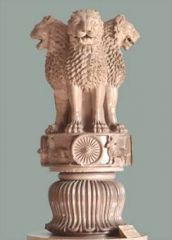
|
Lion Capital from Sarnath Commissioned By Ashoka Chakra and lotuses Greek inspired |
|
|
Reliquary |
An item that is thought to be holy or in once in possession or of use of someone/something that was divine. Think: Great Stupa of Sanchi and how it holds the ashes of Buddha |
|
|
Aniconic |
absence of material representation of anything in art. Think: Great Departure at Great Stupa of Sanchi |
|
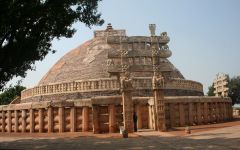
|
Great Stupa, Sanchi, India 200 BCE Commissioned By Ashoka Pilgrimage Site because of Reliquary Think: Solid dome- Earth, womb, cycle of life Interesting: Solid dome- meant to be walked around and connected with |
|
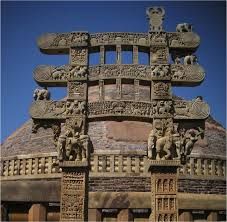
|
East Torana from the Great Stupa at Sanchi Think: Great Departure 3 archetype representing the 3 worlds Gateway Creates the marker between material world and sacred ground |
|

|
Great Departure, scene from the East Torana, Sanchi Think: Aniconic Buddha is not depicted physically but his presence is represented by the context The 3 horses leaving the castle of Buddha's former housing |
|
|
Mahayana Buddhism |
Sect of Buddhism that is centralized around Northern India Think: Ajanta Caves |
|
|
Iconography |
Symbols in a work of art Think: Seated Buddha and his chakras, lotus, and physical markers of his enlightenment |
|
|
Chakra |
Centers of Human Spiritual Power in the human body Think: Seated Buddha |
|
|
Sanghati |
The extra robe that is often folded and placed over buddha's shoulder |
|
|
Ushnisha |
three dimensional oval at the head of buddha representing his divine guidance |
|
|
Urna |
a circular dot or spiral on the forehead to symbolize the third eye's vision into the divine world |
|
|
Lakshana |
form of Hindu philosophy |
|
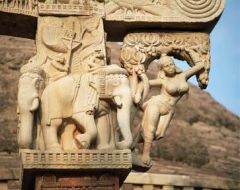
|
Yakshi from the East Torana, Sanchi Yakshi is a female tree spirit |
|
|
Pillars of Ashoka |
Pillars Emperor Ashoka commissioned to mark the sites of Buddha's sermons Many erected Many destroyed Some more decorated than others all freestanding pillars some with capitals Think: Lion Capital from Sarnath |
|
|
Standings Buddhas From Gandhāra |
Greco-Roman standing buddhas Contrapasto poses. Close to body drapery that shows body |

